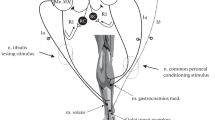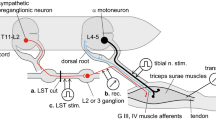Summary
The reflex activation of flexor muscle spindles by stimulation of the gastrocnemius nerve (fusimotor reflex) has been investigated with regard to the part played by the low threshold gastrocnemius afferents in the induction of the reflex.
The discharge in all of 57 primary afferents could be enhanced by stimulation of the gastrocnemius nerve with approximately twice the threshold stimulus strengths for the induction of the nerve action potential in the gastrocnemius nerve. The average increase in the discharging rate was 10 imp./sec. The average value of the latency time for the fusimotor reflex was 166 msec.
The reflex could be readely blocked using procaine on the peroneus nerve in a concentration predilectively blocking efferents (this was taken as evidence for the involvement of the γ-fusimotor fibers in the reflex mechanism).
The fusimotor reflex seems to increase after decerebration, whereas after spinalization it decreased due to the reduction in suprasegmental drive.
From the results it is concluded, that the coactivation of homonymous α- and γ-motoneurones (classical α-γ-linkage) is only one way to bring the γ-motoneurones into action.
Zusammenfassung
An 57 primären Muskelspindelafferenzen der prätibialen Flexoren wurden durch tetanische Reizung niederschwelliger Afferenzen der heteronym-antagonistischen Nn. gastrocnemii fusimotorische Reflexe ausgelöst. Die Reflexschwellen lagen im Mittel bei etwa dem Zweifachen der Reizstärke, die bei Einzelreizung der Nn. gastroc. ein Nervenaktionspotential auslöste. Die Entladungsrate wurde durchschnittlich um 10 Imp/sec gesteigert; die mittlere Latenzzeit der Reflexe lag bei 166 msec.
Der fusimotorische Reflex konnte durch prädilektive Procainblockade des N. peron. prof. unterbrochen werden, woraus auf eine Beteiligung der γ-Fusimotoneurone geschlossen wurde.
Dezerebrierung scheint den Reflex zu begünstigen, während ihn Spinalisierung durch Wegnahme notwendiger suprasegmentaler Antriebe weitestgehend unterbricht.
Aus den Ergebnissen wurde der Schluß gezogen, daß die Koaktivierung der homonymen α- und γ-Motoneurone nur eine der Möglichkeiten fusimotorischer Aktivität darstellt.
Similar content being viewed by others
Literatur
Barrios, P., J. Haase u.W. Heinrich: Fusimotorische α-Reflexe an prätibialen Flexorenspindeln der Katze. Pflügers Arch. ges. Physiol.296, 49–69 (1967).
Eccles, J. C., R. M. Eccles, A. Iggo, andA. Lundberg: Electrophysiological studies on γ-motoneurones. Acta physiol. scand.50, 32–40 (1960).
Eklund, G., C. von Euler, andS. Rutkowski: Spontaneous and reflex activity of intercostal gamma motoneurones. J. Physiol. (Lond.)171, 139–163 (1964).
Eldred, E., andK.-E. Hagbarth: Facilitation and inhibition of gamma efferents by stimulation of certain skin areas. J. Neurophysiol.17, 59–65 (1954).
Granit, R., S. Skoglund, andS. Thesleff: Activation of muscle spindles by Succinylcholine and Decamethonium. The effects of curare. Acta physiol. scand.28, 134–151 (1953).
Haase, J., u.H.-J. Schlegel: Die fusimotorische Erregung prätibialer Muskelspindeln der Katze während prädilektiver Lokalanaesthesie des Muskelnerven. Pflügers Arch.302, 206–218 (1968).
—, u.B. Vogel: Die reflektorische Aktivierung prätibialer Muskelspindeln durch Spindelafferenzen. Pflügers Arch.311, 168–178 (1969).
Hunt, C. C.: The reflex activity of mammalian small-nerve fibres. J. Physiol. (Lond.)115, 456–469 (1951).
—, andA. S. Paintal: Spinal reflex regulation of fusimotor neurones. J. Physiol. (Lond.)143, 195–212 (1958).
Jansen, J. K. S., andT. Rudjord: Fusimotor activity in a flexor muscle of the decerebrate cat. Acta physiol. scand.63, 236–246 (1965).
Kobayashi, Y., K. Oshima, andI. Tasaki: Analysis of afferent and efferent systems in the muscle nerve of the toad and cat. J. Physiol. (Lond.)117, 152–171 (1952)
Lloyd, D. P. C.: Functional organization in the spinal cord. Physiol. Rev.24, 1–17 (1944).
—: Facilitation and inhibition of spinal motoneurones. J. Neurophysiol.9, 421–438 (1946).
Matthews, P. B. C., andG. Rushworth: The selective effect of procaine on the stretch reflex and tendon jerk of soleus muscle when applied on its nerve. J. Physiol. (Lond.)135, 245–262 (1957a).
——: The relative sensitivity of muscle nerve fibres to procaine. J. Physiol. (Lond.)135, 263–269 (1957b).
Author information
Authors and Affiliations
Rights and permissions
About this article
Cite this article
Schlegel, H.J., Sontag, K.H. Aktivitätssteigerungen in primären Flexor-Muskelspindelafferenzen der Katze bei tetanischer Reizung von Streckreflexafferenzen. Pflugers Arch. 311, 159–167 (1969). https://doi.org/10.1007/BF00587038
Received:
Issue Date:
DOI: https://doi.org/10.1007/BF00587038




